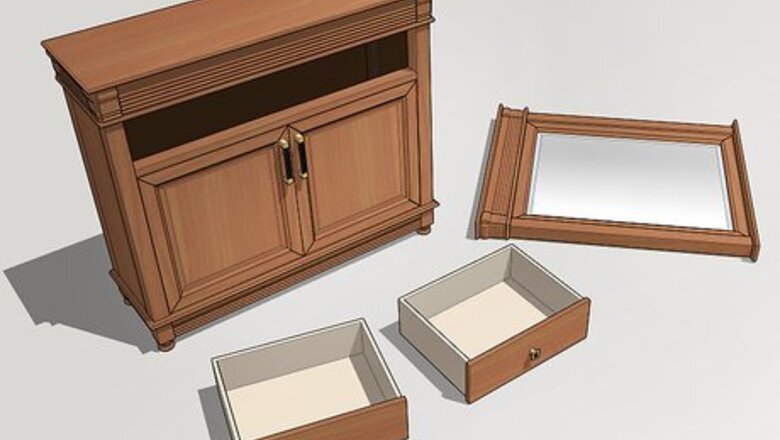
views
- Disassemble large items and break items down into smaller pieces to make things easier.
- Use a dolly, lifting straps, lifting gloves, and/or furniture sliders to make moving bulky and heavy furniture a breeze.
- If you aren’t in complete control of an object when you start to move it, get help. It isn’t safe to move on your own.
Disassemble bigger items.
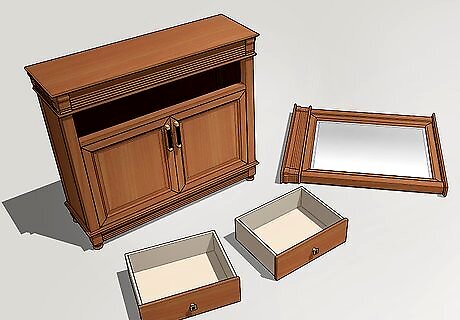
Break down the furniture into its smallest parts. If you are moving a dresser or desk, take out all of the drawers and set them aside. Unscrew the legs off of dressers, desks, bedframes, and tables. Take the leaves out of any tables. Keep all the hardware in a labeled bag so you can assemble your furniture in its new home. You can break down most furniture with a screwdriver or a drill.
Wrap up delicate furniture.

Use bubble wrap or moving blankets to make moving easier. Wrap delicate furniture and items you can’t lift off of the ground entirely. This is also a good idea if the piece has sharp edges to prevent wall damage. Make sure the blanket covers all of the essential parts of your furniture that could get nicked during the moving process. This is especially important if you need to go down any stairs. You can slide a wrapped table top down the steps for example, but if it’s unwrapped you’ll need to carry it all the way.
Give yourself room to maneuver.
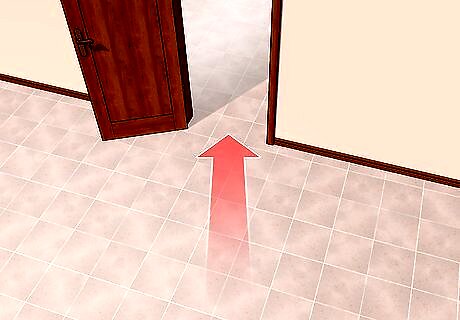
Keep obstacles out of the way and give yourself room to work. Create a clear path for the furniture to avoid nicking things on your way out. If you hit obstacles along the way, you run the risk of damaging your furniture or even hurting yourself. Make sure you have an entirely clear path to move through that is wide enough for your widest piece of furniture and then some. Take the time to remove your doors if you need the extra space to move. Seriously, it’s worth the extra time and effort if your margins are tight!
Put plastic slides under furniture on carpet.
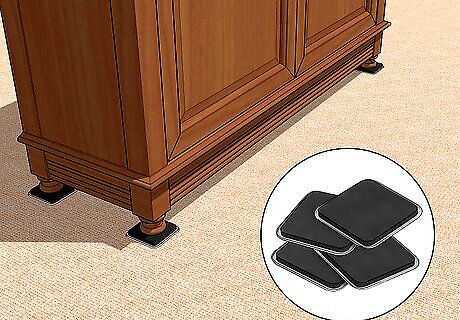
Slide furniture across carpet fast with plastic slides. Furniture slides are small sheets of thin plastic that go underneath large pieces of furniture so you can slide them easily. Lift up one end of a dresser, armoire, or other large, sturdy piece of furniture and slide a furniture slide underneath all of the legs on one side. Slide another furniture slide underneath all of the legs on the other side. Push the top of the furniture piece or use the handles attached to the furniture slides to drag or push the piece of furniture on a carpeted surface. If you push too hard on a tall piece of furniture, it could topple over. Try to push from the middle or the bottom area of the furniture to avoid accidents. You may need to use more than 2 furniture slides for long pieces of furniture.
Use slides or small rugs to push items over hardwood.
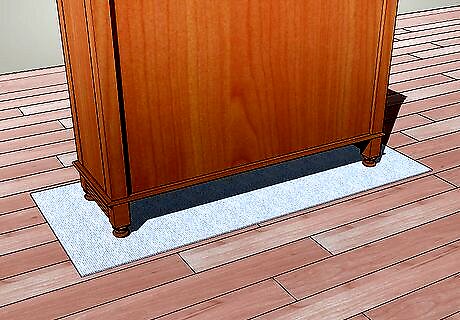
Put a small mat or rug underneath a piece of furniture for hardwood floors. You can slide furniture along your hardwood floors without scratching them by placing a small mat or rug underneath your furniture. Alternatively, you can also use specialized hardwood furniture slides. Either way, carefully lift one side of your furniture and set the mat, rug, or slide underneath as far as it will go. Then, lift the other side of the furniture to slide the mat or rug the rest of the way. Make sure it is underneath all of the legs of your furniture piece. Do not use rugs or mats that have rubber pads on the bottom; they won’t slide along your floor. You can also use upside-down carpet squares in place of a rug, slide, or mat.
Use a dolly to haul heavy items alone.

Lean especially heavy items on a 2-wheel hand dolly. Grab a hand dolly if you’re using a ramp for a truck or you need to move heavy items alone. Gently slide the lip of the dolly underneath one side of the furniture as far as it will go. Slowly lean backward with the furniture until you can use the wheels of the dolly to roll your item safely. Never use a hand dolly on furniture items that are taller than chest height. They’re too much of a fall risk. If you feel like you can’t safely get an item on a dolly or it feels unwieldy when you’re moving the dolly, stop. It’s not worth risking a disaster. Do not use a dolly with stairs if you’re by yourself unless you’re extremely confident you have total control over the item. Use a 4-wheel dolly for especially long or unwieldy items.
Grab a lifting strap for small, bulky items.
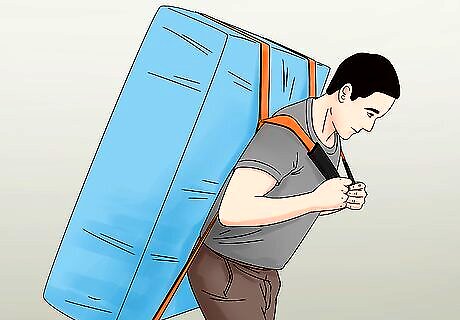
Lifting straps make carrying clunky items a breeze.Lifting straps spread the weight of your furniture and give you easy to use handles or straps to put on or carry. To use a 1-person lifting strap, slide the strap underneath the base of the furniture piece. Put the straps over your shoulders or into both hands. Then, carefully walk with your furniture piece. Never try to carry furniture pieces that are tall or extremely heavy with a furniture strap. If you feel the strap move while you’re carrying the item, set the item down and readjust the grip and strap.
Start by moving and loading the heaviest items.
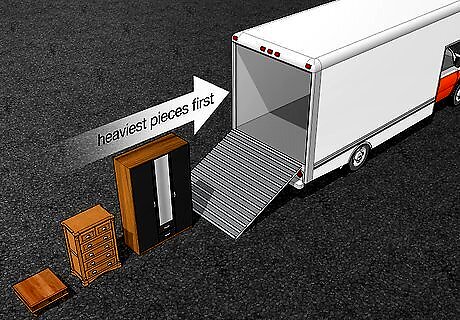
This makes loading and unloading a lot easier. If you are planning on moving large furniture items into a moving truck, put the largest and heaviest pieces in the back of the truck. Place the smaller items towards the front of the truck. This will balance the weight of the truck and make sure nothing topples over while you are driving. This also makes loading a lot easier because you’re getting the tough stuff out of the way first. You’ll probably be tired by the time you unload, so you’ll get to It may be helpful to move all of your furniture out in front of the truck before you pack it.
Cushion heavy items with smaller, softer stuff.
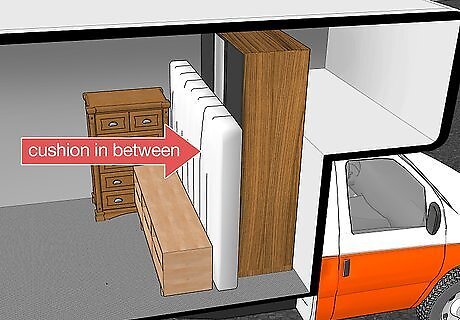
As you pack the truck, keep furniture safe by packing strategically. The biggest risk for your furniture is how it shifts while your moving truck is in motion. To make sure your furniture stays safe, pack smaller, softer items in between your large pieces, like boxes, cushions, and pillows. Make sure that your tall items are secure. Big blankets, bags of clothing, and pillows are your best friends when it comes to building fortresses around big, bulky pieces.
Use the ramp if you rented a moving truck.
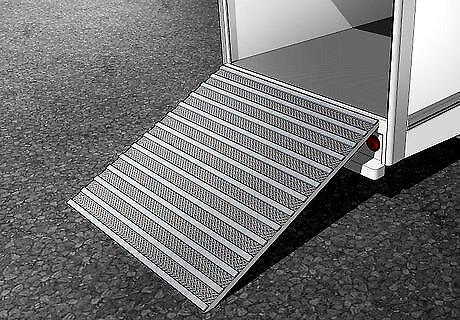
Almost every moving truck has a built-in ramp, so use it! Moving trucks usually have metal ramps that pull down from the back of the truck. Park your truck on a flat surface near your home and pull out the ramp as far as it will go. Make sure the ramp is secure before you walk on it or put any furniture on it. You may need more space than is provided in a parking spot to set up your truck ramp. Park your moving truck in an area with at least 20 feet (6.1 m) of room behind it to avoid hitting any other cars.
Use a hydraulic lift if you don’t have a ramp.

If you can’t roll heavy items, use a lift to get them in the truck. Instead, use a hydraulic lift to raise items up into your truck. It’s just not safe to try lifting a 200–300 lb (91–136 kg) dresser or table. Place your furniture on a hydraulic lift table near the bed of your truck. Use the foot pedal to lift the furniture up to the height of your truck. Then, gently slide the furniture out into the bed of the truck. Secure your furniture down with ropes or straps before driving away.
Bend with your knees, not your back.
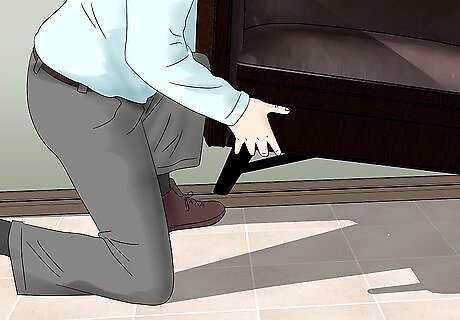
Your strength is in your legs, so avoid straining your back. Stand with your feet shoulder-width apart. Bend your knees until you are squatting in front of the item you want to lift. Keep your back straight. Grab the items with both hands, holding the item close to your body. Use your legs to push yourself back up to a standing position, keeping your back straight. If you have any knee injuries, avoid picking up anything too heavy. Wear a back brace if you want to protect your back from any injuries. Avoid twisting or turning your body too sharply so you don’t hurt your muscles as you are holding something heavy. Keep your back straight and in line with your legs and neck.
Wear sleeves and closed-toed shoes.
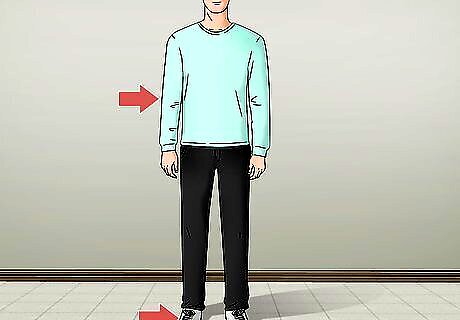
Dress for the job to avoid hurting yourself. Moving furniture can be tough, and there is a chance that you may drop an item on your foot or scratch yourself on a sharp corner. Protect yourself by wearing sturdy, closed-toed shoes and a long-sleeved shirt or jacket. Sneakers, hiking boots, and work boots are all good shoes to wear when moving heavy items. Wear some lifting gloves if you want to protect your hands and get some extra grip!
Don’t push your limits by carrying too much.
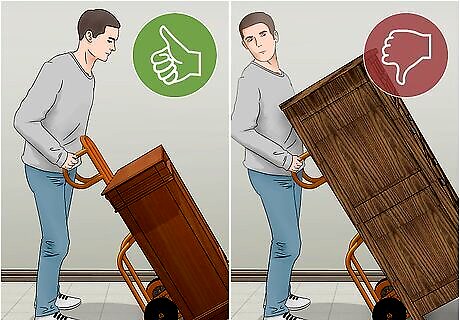
Moving is tough, so get help when you need it. Prevent injury by only carrying items you can safely lift. Everyone has a limit as to what they can safely carry. Do not push yourself into picking up something that you know you cannot handle just because it needs to be moved. Assess your own strength and ask for help with items that are too heavy. If you are carrying something and you realize that it is too heavy, find a safe place to gently put it down.
Be extra careful with stairs.
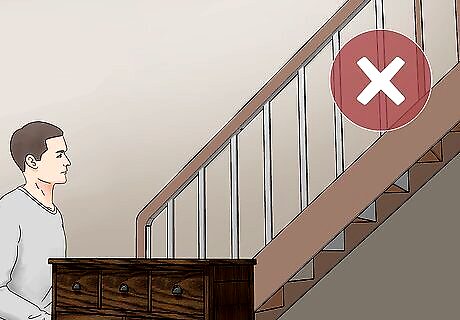
Avoid moving heavy items up or down stairs by yourself. Doing this alone is dangerous, even if you're using a helpful tool like a dolly. Unless you are 100% confident that you’re in complete control, don’t tempt fate on the stairs. If you need help moving heavy furniture up or down stairs, see of one of your neighbors is around and willing to assist you. Most people are glad to help out their new neighbors!




















Comments
0 comment